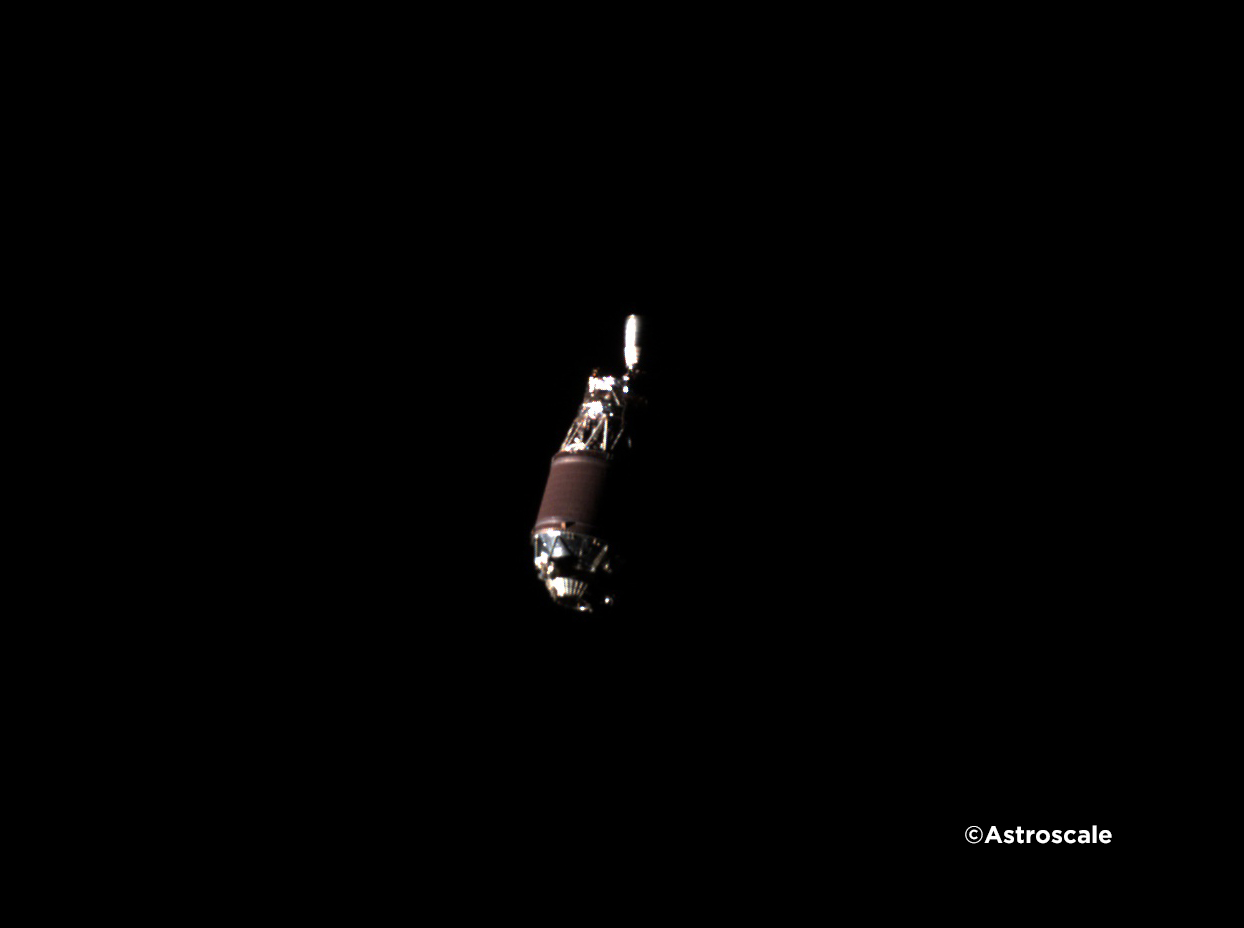Rocket Factory Augsburg, a German launch startup, nears a test-firing of its booster.
This image captured by Astroscale's ADRAS-J satellite shows the discarded upper stage from a Japanese H-IIA rocket. Credit: Astroscale
This image captured by Astroscale's ADRAS-J satellite shows the discarded upper stage from a Japanese H-IIA rocket. Credit: Astroscale
Welcome to Edition 6.42 of the Rocket Report! Several major missions are set for launch in the next few months. These include the first crew flight on Boeing’s Starliner spacecraft, set for liftoff on May 6, and the next test flight of SpaceX’s Starship rocket, which could happen before the end of May. Perhaps as soon as early summer, SpaceX could launch the Polaris Dawn mission with four private astronauts, who will perform the first fully commercial spacewalk in orbit. In June or July, Europe’s new Ariane 6 rocket is slated to launch for the first time. Rest assured, Ars will have it all covered.
As always, we welcome reader submissions, and if you don’t want to miss an issue, please subscribe using the box below (the form will not appear on AMP-enabled versions of the site). Each report will include information on small-, medium-, and heavy-lift rockets as well as a quick look ahead at the next three launches on the calendar.

German rocket arrives at Scottish spaceport. Rocket Factory Augsburg has delivered a booster for its privately developed RFA One rocket to SaxaVord Spaceport in Scotland, the company announced on X. The first stage for the RFA One rocket was installed on its launch pad at SaxaVord to undergo preparations for a static fire test. The booster arrived at the Scottish launch site with five of its kerosene-fueled Helix engines. The remaining four Helix engines, for a total of nine, will be fitted to the RFA One booster at SaxaVord, the company said.
Aiming to fly this year… RFA hopes to launch its first orbital-class rocket by the end of 2024. The UK’s Civil Aviation Authority last month granted a range license to SaxaVord Spaceport to allow the spaceport operator to control the sea and airspace during a launch. RFA is primarily privately funded but has won financial support from the European Space Agency, the UK Space Agency, and the German space agency, known as DLR. The RFA One rocket will have three stages, stand nearly 100 feet (30 meters) tall, and can carry nearly 2,900 pounds (1,300 kilograms) of payload into a polar Sun-synchronous orbit.
Arianespace wins ESA launch contract. The European Space Agency has awarded Arianespace a contract to launch a joint European-Chinese space science satellite in late 2025, European Spaceflight reports. The Solar wind Magnetosphere Ionosphere Link Explorer (SMILE) is a 4,850-pound (2,200-kilogram) spacecraft that will study Earth’s magnetic environment on a global scale. The aim of the mission is to build a more complete understanding of the Sun-Earth connection. On Tuesday, ESA officially signed a contract for Arianespace to launch SMILE aboard a Vega C rocket, which is built by the Italian rocket-maker Avio.
But it may not keep it … In late 2023, ESA member states agreed to allow Avio to market and manage the launch of Vega C flights independent of Arianespace. When the deal was initially struck, 17 flights were contracted through Arianespace to be launched aboard Vega vehicles. While these missions are still managed by Arianespace, Avio is working with the launch provider to strike a deal that would allow the Italian rocket builder to assume the management of all Vega flights. The Vega C rocket has been grounded since a launch failure in 2022 forced Avio to redesign the nozzle of the rocket’s solid-fueled second-stage motor. Vega C is scheduled to return to flight before the end of 2024. (submitted by Ken the Bin)
The easiest way to keep up with Eric Berger's and Stephen Clark's reporting on all things space is to sign up for our newsletter. We'll collect their stories and deliver them straight to your inbox.
Update on ABL’s second launch. ABL Space Systems expected to launch its second light-class RS1 rocket earlier this year, but the company encountered an anomaly during ground testing at the launch site in Alaska, according to Aria Alamalhodaei of TechCrunch. Kevin Sagis, ABL’s chief engineer, said there is “no significant delay” in the launch of the second RS1 rocket, but the company has not announced a firm schedule. “During ground testing designed to screen the vehicle for flight, an issue presented that caused us to roll back to the hangar,” Sagis said, according to Alamalhodaei. “We have since resolved and dispositioned the issue. There was no loss of hardware and we have validated vehicle health back out on the pad. We are continuing with preparations for static fire and launch.”
Nearly 16 months without a launch … ABL’s first RS1 test flight in January 2023 ended seconds after liftoff with the premature shutdown of its liquid-fueled engines. The rocket crashed back onto its launch pad in Alaska. An investigation revealed a fire in the aft end of the RS1 booster burned through wiring harnesses, causing the rocket to lose power and shut off its engines. Engineers believe the rocket’s mobile launch mount was too small, placing the rocket too close to the ground when it ignited its engines. This caused the hot engine exhaust to recirculate under the rocket and led to a fire in the engine compartment as it took off.

Galileo satellites ride with SpaceX. Two European navigation satellites launched on April 27 from Kennedy Space Center in Florida, Spaceflight Now reports. A SpaceX Falcon 9 rocket deployed the twin spacecraft for Europe’s Galileo navigation network into a roughly circular orbit at an altitude of more than 14,000 miles (nearly 23,000 kilometers). The demands of the high-altitude deployment meant the Falcon 9 booster did not have enough leftover propellant to land on a drone ship in the Atlantic Ocean, so SpaceX intentionally expended the rocket. This booster flew 20 times in its career, tying a record for SpaceX’s reusable rocket fleet. Previous Galileo satellites all launched from French Guiana aboard Russian Soyuz or European Ariane 5 rockets, but Europe no longer has access to Soyuz, Ariane 5 is retired, and the new Ariane 6 rocket isn’t ready to fly yet.
Wait, what rocket? … This meant European officials had to pay SpaceX 180 million euros ($193 million) for a pair of Falcon 9 launches to put up four Galileo satellites this year. The contract includes provisions on top of SpaceX’s standard commercial launch service, including the disposal of the Falcon 9 boosters on both launches, and special security measures due to the military utility of the Galileo satellites. The European Commission, which manages the Galileo program, and its partner the European Space Agency (ESA) were uncharacteristically quiet about this launch. Neither organization mentioned the launch at all in the days leading up to the mission, and the EU Space Agency did not identify SpaceX as the launch provider in a post-flight statement. This stands in stark contrast to the way European officials celebrated the launch of previous Galileo satellites. A spokesperson from the commission told Ars that it now considers Galileo satellites “classified.” (submitted by Ken the Bin and EllPeaTea)
Ariane 6 is on the launch pad. Ground crews in French Guiana have raised the core of the first flight-worthy Ariane 6 rocket on its launch pad, replacing a full-scale ground model used for testing last year. Then, at the end of April, teams attached two strap-on solid rocket boosters to each side of the Ariane 6 core, which consists of the vehicle’s cryogenic first and second stages, ESA said in an update. This step involved raising the core vehicle with a lifting beam and moving the boosters into position next to their attachment points. Now installed, the boosters support the full weight of the rocket on the launch pad.
Several milestones still to come … With most of the Ariane 6 rocket now on the launch pad, the launch team will proceed into functional testing and launch rehearsals. These tests will include at least one fueling exercise, in which the rocket will be loaded with liquid hydrogen and liquid oxygen propellants. In France, engineers will soon complete an “all-encompassing” four-week qualification review of the Ariane 6 launcher, ESA said. The small satellites that will ride the first Ariane 6 rocket into orbit are scheduled to arrive at the French Guiana launch site later this month. The satellites will be encapsulated inside the Ariane 6 payload fairing and then raised on top of the rocket ahead of the first launch attempt, which could happen in a window between June 15 and July 31. (submitted by EllPeaTea and Ken the Bin)
Astroscale chases down a dead rocket. A satellite operated by Japanese company Astroscale has chased down a 15-year-old piece of space junk and taken an up-close image of it, the BBC reports. The space junk is the discarded upper stage from a Japanese H-IIA rocket that has been in orbit since 2009. It’s about 36 feet by 15 feet (11 meters by 4 meters) in size, with a mass of about 3 metric tons. Ars reported on the launch of the ADRAS-J mission in February. Since then, the small satellite has pursued the spent H-IIA rocket with a series of thruster burns in low-Earth orbit. In April, ADRAS-J took a picture of the H-IIA rocket from a range of several hundred meters. Astroscale says this is the first publicly released image of space debris captured through rendezvous and proximity operations.
Cleaning up low-Earth orbit … Astroscale was founded with a goal of removing large pieces of space junk from orbit and has since branched out to other business areas like satellite servicing. The ADRAS-J mission is a public-private partnership between Astroscale and JAXA, Japan’s space agency, to demonstrate the technologies required for approaching an out-of-control satellite or rocket. This spacecraft will continue flying closer to the H-IIA rocket to obtain more imagery while Astroscale develops a follow-on mission to approach the same rocket body, latch onto it with a robotic arm, and deorbit it in an end-to-end demonstration of space debris removal.
China preps to launch Chang’e 6. China is set to launch its first sample return mission to the far side of the Moon on Friday, Space News reports. The robotic Chang’e 6 mission will launch on a heavy-lift Long March 5 rocket from the Wenchang Satellite Launch Center on Hainan Island and target a landing in the southern portion of Apollo crater within the South Pole-Aitken Basin, a gigantic, ancient impact basin that is thought to hold tantalizing clues about a number of Moon mysteries. Getting samples back to Earth from this region of the Moon has been on the wish list of international scientists for decades. Chang’e 6 will try to bring back up to 4.4 pounds (2 kilograms) of lunar material.
Building on the past … Chang’e 6 follows China’s Chang’e 4 and Chang’e 5 missions in 2019 and 2020. Chang’e 4 made the first soft landing on the far side of the Moon, and Chang’e 5 returned material from the side of the Moon always facing Earth. In March, China launched a data relay satellite to link ground controllers with Chang’e 6 on the back side of the Moon, where there is no direct line-of-sight communications with Earth.

Questions remain about Artemis II. The heat shield on NASA’s Orion chipped away more than engineers expected when it reentered the atmosphere at the end of the Artemis I mission in 2022. NASA still doesn’t fully understand why this happened, Ars reports. “We are still in the middle of our investigation on the performance of the heat shield from Artemis I,” said Amit Kshatriya, a NASA manager who oversees development for the Artemis lunar missions. Only once engineers understand the fundamental cause of the heat shield issue will NASA decide how to proceed with Artemis II, the first time astronauts will fly around the Moon on the Orion spacecraft. This is the most significant risk to Artemis II’s scheduled launch date in September 2025. Components for the Space Launch System rocket and ground systems at NASA’s Kennedy Space Center are on track to support the Artemis II mission before then.
Unhelpful and redundant … NASA’s inspector general released a report Wednesday adding more details and providing the first pictures of the Artemis I heat shield. Catherine Koerner, who leads NASA’s exploration directorate, wrote in response to the report that the “redundancy” in its recommendations “does not help to ensure whether NASA’s programs are organized, managed, and implemented economically, effectively, and efficiently.” A careful reading of the second sentence reveals that Koerner feels that the inspector general’s efforts are both redundant and unhelpful. This is startling language. Of course, NASA engineers already know all the details about this heat shield issue and have access to these images. But without this report, the taxpayers paying the bills for the Artemis program wouldn’t. That’s the point of watchdogs like the inspector general.
Starship refueling plans come into focus. Sometime next year, NASA believes SpaceX will be ready to link two Starships in orbit for an ambitious refueling demonstration, a technical feat that will put the Moon within reach, Ars reports. SpaceX’s plan to land astronauts on the Moon for NASA relies on multiple refuelings of its Starship spacecraft in low-Earth orbit. But first, SpaceX needs to demonstrate it can do it at all. A ship-to-ship transfer of cryogenic propellants has never been attempted by anyone before.
ConOps … SpaceX’s concept of operations for the ship-to-ship propellant transfer involves two Starship launches from the same launch pad in Texas. The first vehicle will loiter in low-Earth orbit for several weeks until the second Starship, playing the role of a tanker, lifts off and chases it down. The two ships will dock together and autonomously mate fluid connections. Then, using a pressure differential, the donor vehicle will begin flowing propellants into the tanks on the recipient vehicle. This isn’t easy and will require mastery of thermal and pressure conditions to prevent boil-off of cryogenics and the use of small settling thrusters to generate a small amount of artificial gravity to force the fluids toward the outlet to flow from one ship to another. NASA’s top manager in charge of the Artemis Human Landing System anticipates several ship-to-ship propellant transfer demonstrations before SpaceX is ready to send Starship to the Moon.
Next three launches
May 3: Falcon 9 | Starlink 6-55 | Cape Canaveral Space Force Station, Florida | 01:49 UTC
May 3: Long March 5 | Chang’e 6 | Wenchang Space Launch Site, China | 09:30 UTC
May 6: Falcon 9 | Starlink 6-56 | Cape Canaveral Space Force Station, Florida | 15:34 UTC

Stephen Clark is a space reporter at Ars Technica, covering private space companies and the world’s space agencies. Stephen writes about the nexus of technology, science, policy, and business on and off the planet.


